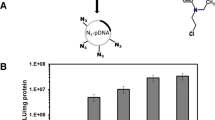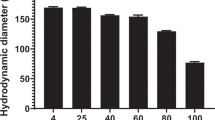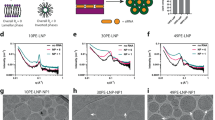Abstract
We have developed a modified poly(ethylenimine) (PEI) transfection procedure that significantly increases PEI’s transfection efficiency. While the basic transfection procedure had a transfection efficiency of 37%, our modified procedure yielded a 53% transfection efficiency. The altered procedure gives improved results because of two simultaneous actions: free polycations are removed from the transfecting solutions, and the composition of the PEI complexes that are administered to cells has been modified. The reduction in the amount of free polycations in transfecting solutions reduced the toxicity sometimes associated with the administration of polycations to cellular environments. The structural modification of PEI/DNA transfecting complexes involves improved PEI packing around the delivered plasmid to yield a greater buffering capacity without a change in the complex’s surface charge concentration. These structural properties were confirmed by titration and ζ potential analyses. Whether the modified PEI/DNA complexes are more effective because of increased cellular uptake or an enhanced ability to escape from endolysosomes has been addressed. The increase in transfection efficiency was obtained when the buffering capacity of the PEI/DNA was increased without a change in surface charge concentration, which implies that it is the property of enhanced lysosomal buffering that is responsible for successful PEI transfection.
This is a preview of subscription content, access via your institution
Access options
Subscribe to this journal
Receive 12 print issues and online access
$259.00 per year
only $21.58 per issue
Buy this article
- Purchase on Springer Link
- Instant access to full article PDF
Prices may be subject to local taxes which are calculated during checkout









Similar content being viewed by others
References
Boussif O et al. A versatile vector for gene and oligonucleotide transfer into cells in culture and in vivo: polyethylenimine Proc Natl Acad Sci USA 1995 92: 7297–7301
Lambert RC et al. Polyethylenimine-mediated DNA transfection of peripheral and central neurons in primary culture: probing Ca2+ channel structure and function with antisense oligonucleotides Molec and Cell Neurosci 1996 7: 239–246
Boussif O, Zanta MA, Behr JP . Optimized galenics improve in vitro gene transfer with cationic molecules up to 1000-fold Gene Therapy 1996 3: 1074–1080
Abdallah B et al. A powerful nonviral vector for in vivo gene transfer into the adult mammalian brain: polyethylenimine Hum Gene Ther 1996 7: 1947–1954
Boletta A et al. Nonviral gene delivery to the rat kidney with polyethylenimine Hum Gene Ther 1997 8: 1243–1251
Godbey WT, Wu KK, Mikos AG . Size matters: molecular weight affects the efficiency of poly(ethylenimine) as a gene delivery vehicle J Biomed Mat Res 1999 45: 268–275
Dunlap DD, Maggi AS, Marco R, Monaco L . Nanoscopic structure of DNA condensed for gene delivery Nucleic Acids Res 1997 25: 3095–3101
Helander IM, Latva-Kala K, Lounatmaa K . Permeabilizing action of polyethylenimine on Salmonella typhimurium involves disruption of the outer membrane with lipopolysaccharide Microbiology 1998 144: 385–390
Widom J, Baldwin RL . Cation-induced toroidal condensation of DNA studies with Co3+(NH3)6 J Molec Biol 1980 144: 431–453
Kim JS, Maruyama A, Akaike T, Kim SW . In vitro gene expression on smooth muscle cells using a terplex delivery system J Control Rel 1997 47: 51–59
Labat-Moleur F et al. An electron microscopy study into the mechanism of gene transfer with lipopolyamines Gene Therapy 1996 3: 1010–1017
Nemati F . PhD. dissertation University of Paris IX 1996
Helander IM, Alakomi HL, Latva-Kala K, Koski P . Polyethylenimine is an effective permeabilizer of gram-negative bacteria Microbiology 1997 143: 3193–3199
Godbey WT, Wu KK, Mikos AG . Tracking the intracellular path of poly(ethylenimine) for gene delivery Proc Natl Acad Sci USA 1999 96: 5177–5181
Ferrari S et al. ExGen 500 is an efficient vector for gene delivery to lung epithelial cells in vitro and in vivo Gene Therapy 1997 4: 1100–1106
Plank C, Mechtler K, Szoka FC, Wagner E . Activation of the complement system by synthetic DNA complexes: a potential barrier for intravenous gene delivery Hum Gene Ther 1996 7: 1437–1446
Hunter RJ . Zeta Potential in Colloid Science: Principles and Applications Academic Press: New York 1981
Edgell CJ, McDonald C, Graham JB . Permanent cell line expressing human factor VIII-related antigen established by hybridization Proc Natl Acad Sci USA 1983 80: 3734–3737
Suggs JE, Madden MC, Friedman M, Edgell CJ . Prostacyclin expression by a continuous human cell line derived from vascular endothelium Blood 1986 68: 825–829
Bailey FE, Koleske JV . Solution properties of polyl(ethylene oxide) Poly(Ethylene Oxide) Academic Press: New York 1976 pp 29–86
Acknowledgements
This material is based upon work supported under a National Science Foundation Graduate Fellowship (WTG) and the National Institutes of Health (R29-AR42639) (AGM), (PSO-NS-23327) (KKW), and (R01-HL-50675) (KKW). We also wish to thank Nancy Turner and Dr Tom Chow for their assistance with the FACScan, as well as Steve Yang for his guidance in the use of the DELSA 440 (ζ potential). We are also grateful to Dr Cora-Jean Edgell for providing the EA.hy 926 cell line.
Author information
Authors and Affiliations
Rights and permissions
About this article
Cite this article
Godbey, W., Wu, K., Hirasaki, G. et al. Improved packing of poly(ethylenimine)/DNA complexes increases transfection efficiency. Gene Ther 6, 1380–1388 (1999). https://doi.org/10.1038/sj.gt.3300976
Received:
Accepted:
Published:
Issue Date:
DOI: https://doi.org/10.1038/sj.gt.3300976
Keywords
This article is cited by
-
Nanoparticles loaded with circ_0086375 for suppressing the tumorigenesis of pancreatic cancer by targeting the miR-646/SLC4A4 axis
Clinical & Experimental Metastasis (2023)
-
Overcoming the non-kinetic activity of EGFR1 using multi-functionalized mesoporous silica nanocarrier for in vitro delivery of siRNA
Scientific Reports (2022)
-
An efficient, non-viral dendritic vector for gene delivery in tissue engineering
Gene Therapy (2017)
-
History of Polymeric Gene Delivery Systems
Topics in Current Chemistry (2017)
-
Electrospinning strategies of drug-incorporated nanofibrous mats for wound recovery
Drug Delivery and Translational Research (2015)



